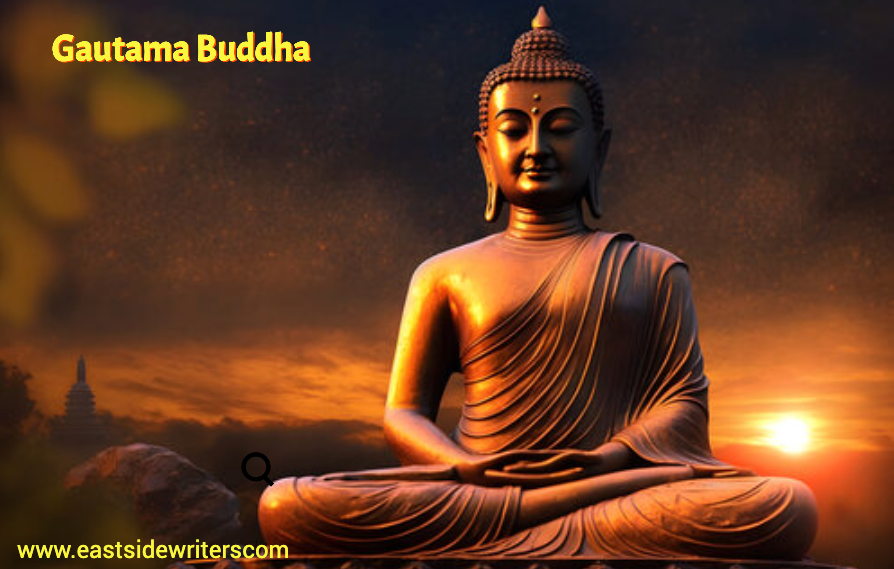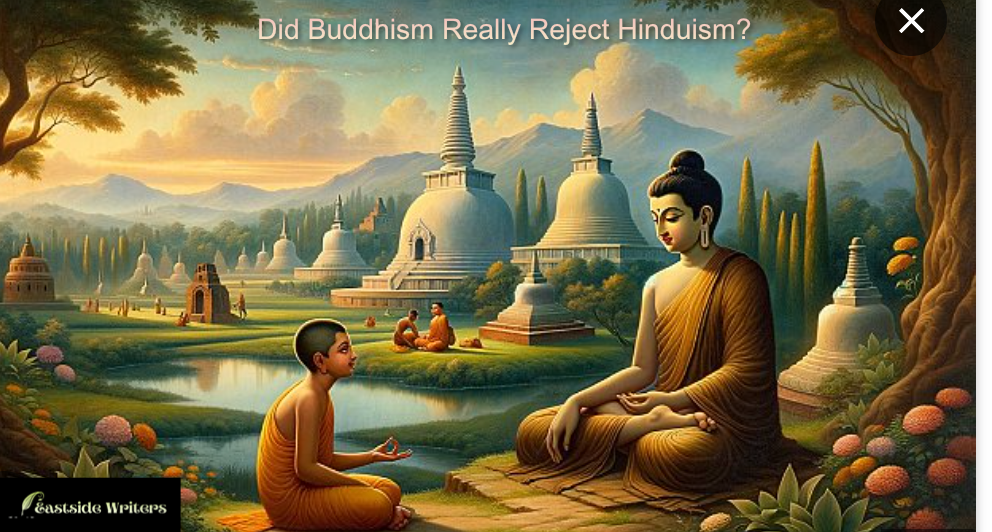Did Buddhism really reject Hinduism? This question has fascinated scholars and spiritual seekers for centuries. Buddha’s journey—from a Hindu prince to the enlightened founder of a new spiritual path—was not just a personal quest but a profound shift in religious thought. Born and raised in a Hindu society, Siddhartha Gautama (the Buddha) ultimately questioned many practices and beliefs within the prevailing Vedic traditions, leading to the rise of Buddhism. However, was this path intended as a direct rejection of Hinduism, or simply a new way of addressing human suffering?
In this blog, we’ll unravel Buddha’s perspective, exploring why he distanced himself from some Hindu practices and how his teachings evolved into a distinct spiritual path. We’ll also dive into the key differences and shared values between Buddhism and Hinduism, shedding light on why Buddha’s teachings still resonate today. By understanding the true intentions behind Buddhism’s emergence, we can gain deeper insights into one of the world’s most influential spiritual traditions and its complex relationship with Hinduism.

Understanding the Historical Context
To understand the relationship between Buddhism and Hinduism, it’s crucial to look at the historical and cultural context of ancient India. Siddhartha Gautama, who later became the Buddha, was born in the 5th century BCE in the region that now lies between modern-day India and Nepal. At the time, Hinduism was the predominant religion, though it looked quite different from the Hinduism we know today.
In ancient India, Hindu society was deeply structured, with rigid class distinctions that influenced people’s social, economic, and spiritual lives. Vedic Brahmanism, with its elaborate rituals and emphasis on caste hierarchy, dominated the religious landscape. Siddhartha Gautama’s dissatisfaction with these societal norms and religious practices led him to seek a different path.
The Early Life of Siddhartha Gautama: A Hindu Prince
Siddhartha’s Background and Hindu Roots
Siddhartha Gautama was born into the Shakya clan, a warrior class, and was raised as a prince in a Hindu society. His family followed the Vedic traditions, worshipping Hindu deities and observing rituals. In this sense, Siddhartha was indeed born and raised as a Hindu. His early life was filled with luxury, which shielded him from the harsher realities of life outside the palace walls. But his encounter with suffering changed everything.
The Great Renunciation and Quest for Enlightenment
The Buddha’s spiritual journey began when he saw the “Four Sights”: an old man, a sick man, a corpse, and an ascetic. These sights represented aging, sickness, death, and renunciation, stirring a profound existential crisis within him. Siddhartha realized that no amount of worldly pleasure or material wealth could shield him from suffering. This prompted him to renounce his princely life in search of a deeper truth that could address human suffering.
What Buddha’s Teachings Really Emphasized
The Four Noble Truths and the Eightfold Path
Buddha’s teachings primarily revolved around the Four Noble Truths and the Eightfold Path, which were his framework for understanding and overcoming suffering. Rather than advocating for ritualistic practices or caste distinctions, Buddha’s teachings emphasized mindfulness, ethical conduct, and mental discipline.
The Four Noble Truths: Understanding the Reality of Suffering (Dukkha) and the Path to Liberation
The core of Buddha’s teachings lies in the Four Noble Truths, which offer profound insights into the nature of human existence and the path toward spiritual liberation. These truths are not merely philosophical concepts; they are practical frameworks for understanding and overcoming suffering.
- The First Noble Truth: Dukkha (Suffering)
The first noble truth states that life is inherently filled with suffering, known as dukkha. This suffering can take many forms: physical pain, emotional distress, dissatisfaction, and existential angst. Buddha emphasized that suffering is an integral part of the human experience. It is important to recognize that this suffering is not limited to extreme pain or grief; even moments of happiness can be tinged with impermanence, as they are fleeting and will eventually pass. By acknowledging the reality of dukkha, individuals can begin to confront the deeper issues in their lives rather than avoid them. This awareness is the first step toward liberation. Buddha taught that understanding the nature of suffering helps individuals cultivate compassion for themselves and others, fostering a more profound sense of connection and empathy. - The Second Noble Truth: Samudaya (The Cause of Suffering)
The second noble truth identifies the origins of suffering. Buddha taught that suffering arises from tanha, which translates to craving or attachment. This craving manifests in various forms—desires for pleasure, material possessions, or even the longing for existence itself. This relentless pursuit leads to a cycle of suffering, as fulfilling one desire often gives rise to new cravings. Recognizing the roots of suffering encourages individuals to examine their attachments and desires critically. By understanding how craving perpetuates suffering, practitioners can start to loosen their grip on these attachments, allowing for greater emotional freedom and peace. - The Third Noble Truth: Nirodha (The Cessation of Suffering)
The third noble truth offers hope: it asserts that suffering can be overcome. This cessation of suffering, known as nirodha, is achievable through the relinquishment of craving and attachment. When individuals let go of their desires, they can experience a state of inner peace and liberation from the cycles of birth and death (samsara). This state is referred to as nirvana, a profound realization of enlightenment that transcends suffering. Buddha’s teaching emphasizes that the path to nirohttps://en.wikipedia.org/wiki/Nirodhadha is not passive; it requires active engagement in one’s spiritual journey. Through mindful living and ethical conduct, individuals can cultivate a deeper understanding of themselves and the world around them. - The Fourth Noble Truth: Magga (The Path to Liberation)
The fourth noble truth outlines the path leading to the cessation of suffering: the Eightfold Path. This path provides a practical guide for ethical and mental discipline, enabling individuals to cultivate wisdom, ethical conduct, and mental focus. By following this path, practitioners can transform their understanding and experience of life.

The Eightfold Path: A Practical Guide to Ethical and Mental Discipline
The Eightfold Path is divided into three essential categories: wisdom (prajna), ethical conduct (sila), and mental discipline (samadhi). Each aspect of the path is interconnected, reinforcing the others in the pursuit of enlightenment.
- Right Understanding (Samma Ditthi)
This involves understanding the nature of reality and the truth of the Four Noble Truths. Right understanding encourages individuals to see the world as it is, free from misconceptions and illusions, allowing for a clearer perspective on life’s challenges. - Right Intent (Samma Sankappa)
Right intent refers to the commitment to ethical and mental growth. It involves cultivating intentions of love, compassion, and non-attachment. By fostering positive intentions, individuals can influence their thoughts and actions, leading to a more harmonious existence. - Right Speech (Samma Vaca)
This aspect emphasizes the importance of truthful, compassionate, and constructive communication. Right speech encourages individuals to refrain from lying, gossiping, or using harmful words. Speaking mindfully fosters healthier relationships and promotes understanding and compassion. - Right Action (Samma Kammanta)
Right action calls for ethical conduct and moral behavior. It involves acting in ways that do not harm others, adhering to ethical precepts such as refraining from killing, stealing, or engaging in sexual misconduct. By practicing right action, individuals contribute to a more compassionate world. - Right Livelihood (Samma Ajiva)
Right livelihood emphasizes the importance of earning a living in a manner that does not harm others. This includes avoiding occupations that exploit, deceive, or cause harm to people and animals. Engaging in ethical work supports personal and societal well-being. - Right Effort (Samma Vayama)
The right effort involves cultivating positive states of mind while overcoming negative ones. This requires diligence and perseverance in pursuing spiritual growth. Practitioners must strive to develop wholesome qualities and reduce unwholesome ones through consistent effort and mindfulness. - Right Mindfulness (Samma Sati)
Right mindfulness emphasizes awareness of the present moment. It encourages individuals to observe their thoughts, feelings, and sensations without attachment or aversion. Mindfulness practices, such as meditation, enable practitioners to cultivate a deeper awareness of their internal and external experiences. - Right Concentration (Samma Samadhi)
Right concentration involves developing mental focus and achieving deep states of meditation. This mental discipline allows individuals to experience insight and clarity, facilitating a deeper understanding of the nature of reality and ultimately leading to enlightenment.
Rejecting the Rituals and Dogmas of Vedic Brahmanism
Buddha was critical of the rigid and hierarchical structures that characterized Hindu society in his time. He rejected the notion that one’s spiritual worth was determined by birth or social standing. Instead, Buddha emphasized individual responsibility and the pursuit of enlightenment through personal effort and introspection, making his teachings accessible to all, regardless of caste or social status.
Did Buddha Really Start a New Religion?
Buddhism as a Reform Movement
There is considerable debate over whether Buddha intended to establish a new religion. Some scholars argue that Buddhism was initially a reform movement within the broader Vedic tradition. Buddha’s teachings were seen as a direct response to the rigidity of Vedic Brahmanism and its caste hierarchies. He offered an alternative path to spiritual liberation that didn’t rely on external rituals or priestly intercession.
Why Buddhism Eventually Became Distinct
Over time, Buddha’s teachings evolved into a separate tradition due to the differences in philosophy, practice, and focus. Buddhism’s emphasis on meditation, non-attachment, and compassion set it apart from the Vedic traditions, giving rise to a unique spiritual movement that transcended geographical and cultural boundaries. This evolution reflects not only the teachings of the Buddha but also the social and cultural shifts happening in ancient India.

Examining Buddhism and Hinduism: Key Differences and Similarities
Core Philosophical Differences
Belief in the Soul (Atman)
Hinduism teaches the concept of Atman, an eternal, individual soul, whereas Buddha rejected the notion of an unchanging, permanent self. This rejection, known as anatta (non-self), is one of the key philosophical distinctions between Buddhism and Hinduism.
The Caste System
The caste system was a fundamental part of Hindu society in Buddha’s time. Buddha’s teachings actively opposed this system, advocating instead for a path accessible to all, regardless of birth or status. This inclusive approach helped Buddhism appeal to those marginalized by the caste hierarchy.
Views on God and Rituals
While Hinduism is rich with deities and rituals, Buddha’s teachings do not emphasize a god-centric or ritualistic approach to spirituality. Instead, Buddhism focuses on personal enlightenment through meditation and ethical living.
Common Spiritual Concepts
Karma and Reincarnation
Both Buddhism and Hinduism share the belief in karma and reincarnation. However, Buddha redefined these concepts, interpreting karma as a result of intentional actions rather than a fixed cosmic law.
The Pursuit of Liberation
Both traditions aim for liberation from the cycle of birth, death, and rebirth. In Hinduism, this liberation is called moksha, while in Buddhism, it’s known as nirvana. The path to achieving this, however, differs between the two traditions.
Is Buddhism Anti-Hindu?
Understanding the Non-Dualistic Approach of Buddhism
Buddha’s teachings were not explicitly anti-Hindu but were instead a response to the societal and religious challenges of his time. Buddhism doesn’t promote animosity toward any other religion, including Hinduism. In fact, the teachings of Buddha emphasize compassion, tolerance, and understanding.
How Buddhism and Hinduism Have Coexisted and Interacted
Historically, Buddhism and Hinduism have coexisted peacefully in many regions. While they developed distinct identities, they share a common cultural and spiritual heritage that has allowed for mutual respect and exchange of ideas. Hinduism, for instance, adopted some Buddhist principles, such as non-violence (ahimsa), and incorporated Buddha into its pantheon as an avatar of Vishnu in certain traditions.
The Decline of Buddhism in India
One reason for the perception of Buddhism as being “anti-Hindu” may be related to its historical decline in India. With the rise of devotional Hinduism and the establishment of a unified Hindu identity, Buddhism gradually lost its foothold in its birthplace. However, many scholars argue that this decline was due to sociopolitical factors rather than any inherent antagonism between the two religions.
Lesser-Known Facts About Buddha and Buddhism
Buddha Did Not Claim Divinity
Unlike many religious founders, Buddha did not claim to be divine or a prophet of a deity. He presented himself as a teacher, a guide to enlightenment, and encouraged followers to question and understand his teachings for themselves.
Buddhist Influence on Later Hindu Thought
Certain Buddhist concepts, such as compassion and non-violence, were later incorporated into Hindu teachings. The influence of Buddhism is also evident in certain schools of Hindu philosophy, such as Advaita Vedanta, which adopted and adapted concepts of non-duality.
The Spread of Buddhism Beyond India
Buddhism spread to many regions across Asia, including Sri Lanka, Southeast Asia, China, and Japan. Each region adapted Buddhism to its unique cultural context, resulting in various schools of thought like Mahayana and Vajrayana Buddhism.

Conclusion:
Buddhism and Hinduism—A Complex Relationship
In conclusion, Buddhism is not inherently anti-Hindu. Rather, it represents an evolution of spiritual thought that arose in response to the social, religious, and philosophical challenges of its time. While Buddha’s teachings differ from the Hindu traditions of his era, they were not meant to oppose or undermine Hinduism. Instead, they provided an alternative path, one that emphasized individual responsibility and the pursuit of enlightenment.
Buddhism and Hinduism share a rich, intertwined history that has allowed them to coexist, interact, and influence each other over millennia. Understanding this complex relationship requires recognizing both the differences and shared values that connect these two ancient spiritual paths. Buddhism’s emphasis on compassion, non-attachment, and mindfulness offers valuable lessons that resonate universally, beyond the boundaries of any one religion.
Disclaimer:
The author’s views are his or her own. The facts and opinions in the article have been taken from various articles and commentaries available in the online media. Eastside Writers nor the writer takes any responsibility or obligation for them.
Note: Contact our Writers at www.eastsidewriters.com for writing Blogs/Articles on any niche. We have experts in various domains from Technology to Finance. Spirituality to Lifestyle and Entertainment.






